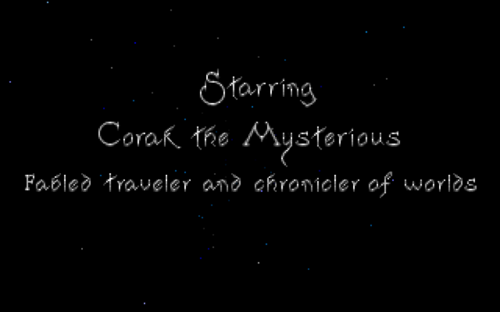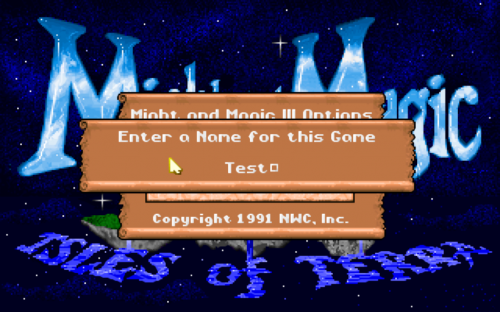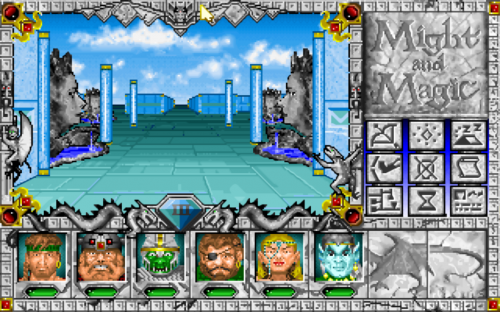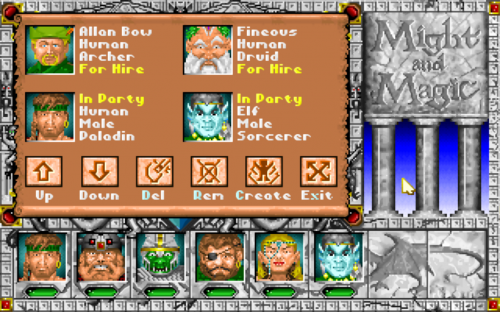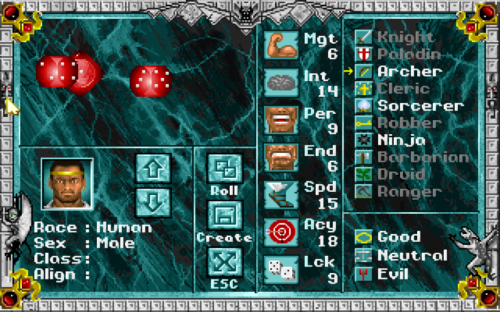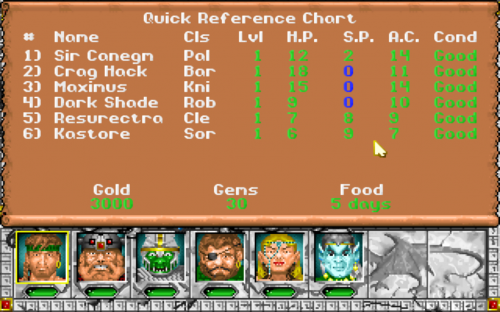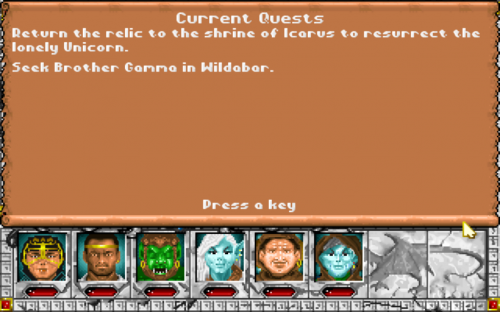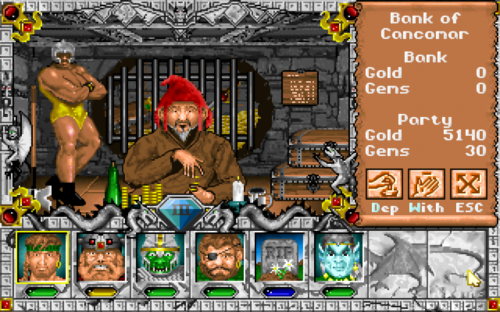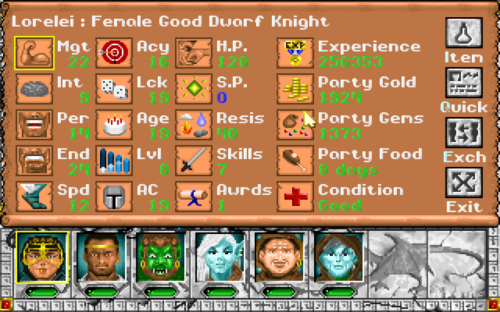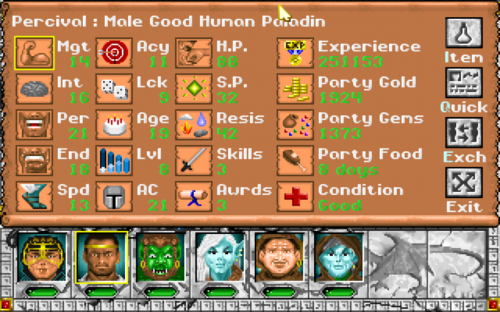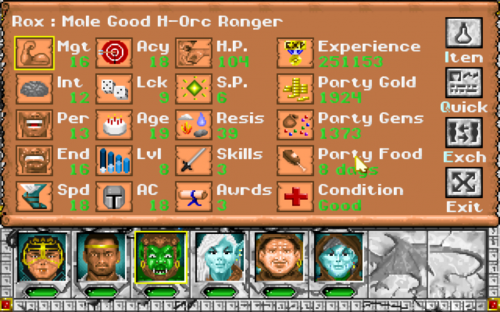It’s been a while, but I’m keeping up with my plans, albeit at a very slow pace. I’ve beaten Might and Magic Book One and Book Two, so now I’m moving on, to Might and Magic III – Isles of Terra. With this one, instead of making up stories, I’ll give an overview of what I’m up to and what the game is about.
Note to newcomers…
…which is what most of you probably are.
The plan I was talking about before the jump was that I wan’t to play through the entire Might and Magic series eventually. I’ve already played through Book One and Book Two and have written extensively about them. In case you’re interested, just so you don’t have to dig through the blog, here are the links to the first two articles related to these two games:
- Might and Magic Book One: Secret of the Inner Sanctum
- Might and Magic Book Two: Gates to Another World
What’s new?
In short, a lot of things. Book Two was very clearly an upgrade to Might and Magic Book One. It did most things the same, with some improvements, changes and tweaks here and there. It made use of newer technology (in a mostly minor way, but still) and it tried to do some things differently. Overall, though, It felt more like a new episode than a new game altogether.
With Might and Magic III, it could not be clearer that it’s a whole new game.
Starting up
Right off the bat, there’s proper music. Not just some short intro tune; actual music. There’s also an animated intro sequence where you see Sheltem.
Then he starts to speak.
Playing through the first four or five quadrants of the game, I’ve yet to encounter speech in-game, but there was speech, actual voices, in the intro. I imagine my kid self would be amazed if I had played this game back when it was first released. Instead, I can play it now, when I can appreciate it more, albeit in a different way and context.
Other than that, the intro sort of feels like an intro to what guys and girls across the pond would call a Saturday morning cartoon. We sort of had something like that here in Croatia as well, but the term itself was never used, to my knowledge.
What I mean is that the intro uses lines such as “Starring Corak the Mysterious” or “Introducing a party of adventurers“, etc. It gives it more of a light atmosphere, which is something I like.
You see, I have an issue with games taking themselves too seriously when most of them fail at actually being serious.
Starting a new game prompts me to enter the name of the game slot. Might and Magic III introduces this concept for the first time in the series. You still only get one save slot, but you can have multiple different game slots. This means you cam play multiple campaigns at the same time, but can’t save in multiple slots within a single campaign.
On a side note, you can also now save and load at will, not exclusively by staying at an Inn in the game. It means you waste less time, but it also creates a potential to get stuck, in a very bad way.
Luckily, there’s a Mr. Wizard feature in the options menu. This is basically a get me out of here option. I don’t intend to use it unless I absolutely have to.
Races and Classes
You start at the entrance to the Forty Winks Inn in the town of Fountain Head, with a pre-made party.
The starting party consists of:
- Sir Conegm, a Male Good Human Paladin
- Crag Hack, a Male Neutral Dwarf Barbarian
- Maximus, a Male Evil Half-Orc Knight
- Dark Shade, a Male Evil Gnome Robber
- Resurectra, a Female Good Gnome Cleric
- Kastore, a Male Neutral Elf Sorceror
As expected, we’re one short of having a total sausage-fest and the only female character has the healer role. It’s a 1991 game, so I didn’t expect anything else. I’m not judging, though, I’m just observing and noticing.
Of course, we already have a party that beat Sheltem twice. I can’t import them this time, but I can recreate them, taking some liberties along the way, to mix things up.
Right off the bat, we can also recruit Allan Bow, a human archer and Fineous, a human druid at the Forty Winks Inn. As in the previous game, they have daily wage you need to pay.
We don’t recruit them, though. Instead, we need to recreate our team of adventurers from the two previous games. Our options are a bit different now, so I’m taking a few liberties.
The choice of races remains the same. We have humans, dwarves, elves, gnomes and half-orcs. As in the previous game, they differ in some initial skill and ability values and resistances, not much else.
The choice of classes has expanded a bit. There’s the knight, paladin, archer, cleric, sorcerer and robber of the first game. There’s also the barbarian and ninja of the second game. Finally, we have the option of a druid and a ranger introduced in this game.
The two new choices also introduce us to something else. There’s a whole new school of magic now – nature magic. Both the druid and the ranger can use this school, with the ranger being less apt at it, kind of like the archer and paladin are weaker spellcasters in their respective schools.
The three schools of magic have some overlaps, but overall, there seems to be an overall tone to each school. Sorcery is offensive, clerical spells are defensive and nature spells are somewhere between the two.
Other mechanical changes
Streamlining was a thing in the last millennium as well.
The thing is, not all streamlining is dumbing things down, regardless of the time period. Some of it makes perfect sense, actually.
For instance, there is no individual gold, gems and food anymore. There’s only party gold, party gems and party food. There are also interface icons and mouse control, so the game is easier to play simply by not being clunky anymore.
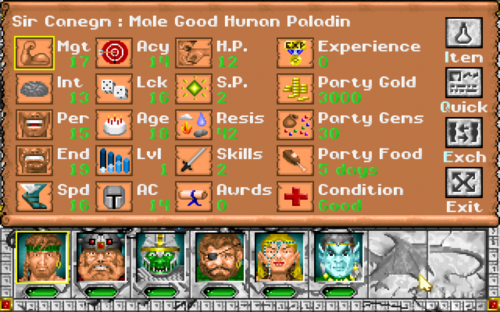
Pictured: The character screen. Clicking any of the icons displays a pop-up with more useful information.
The quick reference chart is still here, and it’s still useful, but it’s not the only way to gain critical information such as character health and afflictions anymore.
The individual character portraits change in appearance when the characters are afflicted with something. They also get icons when they get a beneficial effect cast on them. The gems bellow their portraits change in color based on their level of health to. Green means the health is full, yellow is damaged, red is critically damaged and blue is unconscious.
Might and Magic Book Two introduced skills, but limited them to 2 per character. This made it a bit too limiting and made me completely skip on most of them, only sticking to the few good or required ones on each of my characters. This limit is gone in Might and Magic 3. Instead, each character can have as many skills as they can get.
This is especially welcome with the Crusader skill, which is required to enter castles. You learn it as a reward for conquering an early dungeon and every character in the party gets it for free at that point. In Book Two, I was forced to juggle this skill around as I needed it.
The map screen has been upgraded again, just like it was with the Might and Magic Book One to Book Two transition. If you’re that not into exploring every nook and cranny of the game, you could easily get away with not making your own maps in Might and Magic 3. Not me, though. I’m still mapping away.

Pictured: A map we just started to explore, compared to one fully explored. The top right also shows the mini-map in the second frame.
Auto-mapping now works from the start. There is, however, a skill requirement to show your orientation on the map and in a small icon on the main screen. Without it, you just get an X icon on the map. You also need the Wizard Eye spell in order to use the mini-map in the top right corner of the screen. You can learn it in the second city, or in a hidden area near the first city, once you get the Pathfinding skill.
While we’re on the subject, Pathfinding and Mountaineering remained the same. You again need to character with these skills in order to traverse dense forest and mountain squares.
There are probably other changes I’m forgetting here, but there’s one last thing of note I’d like to mention: You can now have more than one active quest at a time, and there’s an actual rudimentary, but useful quest log. It starts off with a screen that gives you some information about your current location, with the second screen holding a list of your quests.
As with the previous two games, you need to complete quests to complete the game (I’m guessing), but again, there is absolutely no sense of urgency to it. For the most part, your goal is to explore, conquer dungeons and get strong enough in order to be able to complete those quests.
The World
The world has changed, a lot. The game is called Isles of Terra, so obviously, the world is now a set of islands. It’s still divided into sectors, though, and they still use a set of coordinates from A-1 to F-4. That’s just a minor thing, though.
The major thing?
No more random encounters!
Yup, those are gone, completely. In fact, I have yet to find an area where the monsters respawn at all. There’s a fixed set of monsters in each area and region. Once you beat them, the area is safe, not taking potential traps and dangerous terrain into account.
This made me weary at the start, because I like the ability to grind if I want to in an RPG, even if it isn’t necessary. I did some googling, though, and apparently, there are areas where the monsters do respawn. I just haven’t found those yet.
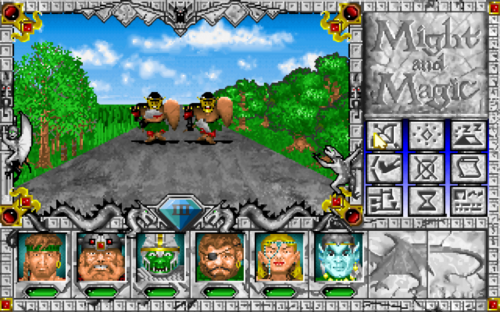
Pictured: A pair of goblins is in view as soon as you leave Fountain Head. They’re actually easier than the monsters inside the city.
A finite amount of monsters and fighting changes the dynamic of exploration a lot. Previously, I would go out, use all of my resources to push through whatever obstacle I could and then go back to save. Every attempt was a net gain because I would at the very least get some money and experience, making the next attempt more likely to succeed.
Now, there’s suddenly a limited amount of money. If someone dies, that’s a bad thing. If I get poisoned or diseased and I’m forced to heal, it’s also a very bad thing. The last few hours of the game was me barely having enough money to continue the game at all.
There are no more combat ranks
Those are gone as well. Since you can see monsters on the map now, ranged combat is available while they’re still a few steps away from you.
From what I can tell, each character now has a chance to be hit, with the characters more to the left on the character panel are more likely to be hit, not taking into account any special modifiers some monsters my have, of course.
Overall, this doesn’t make the combat strategy that different. As usual, the melee combatants should be higher up in party order and they should have a higher AC value. AC does seem to be slightly more important overall, though.
Detailed combat feedback is also gone now, sadly, and this is the one change I can outright say I dislike. I don’t know how much damage my characters are actually doing. A graphical effect flashes when I hit someone, but there are no numbers to be seen.
Larger maps
We are not limited to 16×16 dungeon maps anymore. Some of the dungeons are now 32×32 in size.
With the two dungeons I’ve seen though, the change was purely cosmetic, as the amount of content in the dungeon was about the same. It makes for some variety, though, so it’s a plus for me.
Features!
Really, this and the interface is where the “it’s an upgrade” part of Might and Magic 3 comes into play. The areas of the game world have more interesting, varied and complex features now, and all of it is actually visible on the map, instead of just being described by text.
There are treasure chests that hold items (and traps). There are spell scrolls that teach you spells for free and statues that teach you skills for free or for a price.
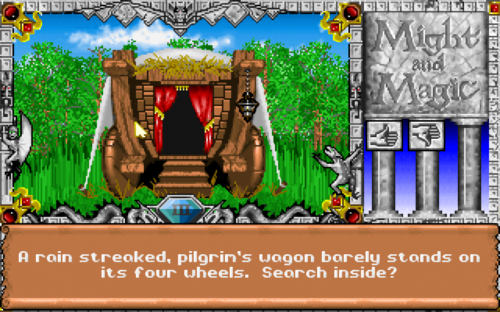
Pictured: First step of the special encounter. There are other encounters with this graphic in the area, so we don’t know what it is yet.
There are puzzle features, such a statue that requires a password to let you pass, or special encounters that require your input before rewarding or killing you.
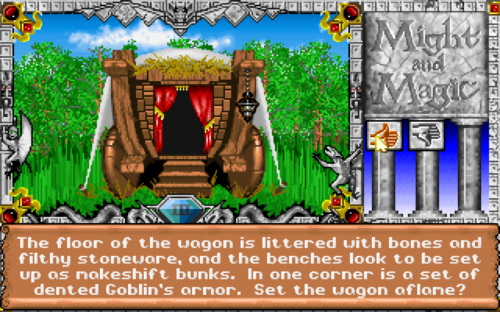
Pictured: Second part of the special encounter. Now we know what it is. Do we want to destroy the wagon?
The game rewards exploration far more than the first two ever did, and there’s actually a tangible goal to it. Once you do explore everything, your map will be filled out and the area won’t be dangerous anymore.
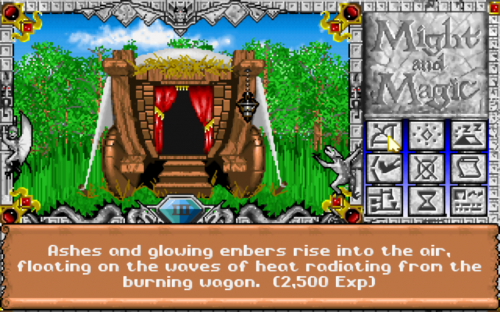
Pictured: Last part of the encounter – the outcome. We get experience and, on the next screen, gold and treasure.
Also, you’ll probably be an order of magnitude stronger than before you got there.
I’m not sure where to put this one thing, but there’s a new town feature in Might and Magic 3 – the bank. You can deposit gold and gems in the bank and they will earn interest. That’s basically it. It’s as simple as that.
For me, this means I have an extra method of grinding. I’m sure there are gold or gem related ways to increase the power of my characters, so having a nice passive income of both will probably end up being great.
Just better overall
Really, that’s the gist of it. Might and Magic Book One and Two are old games. They were made in an era where computers weren’t advanced enough to allow for everything the author wanted to make to actually be made. Because of it, a big part of the game was abstracted and left to the imagination. Also because of it, a very compelling and interesting set of mechanics came into reality.
With Might and Magic 3, there’s a much bigger technological jump. Part of the abstraction is gone, but luckily a big part is still leftover. A big advantage for Might and Magic is that the game isn’t trying to be too serious. That approach is something that can make a game more fun, because the author focuses on the game instead of the presentation (as in, it’s not all about immersion, which is an overused word I’m starting to strongly dislike these days).
The heroes of Varn and Cron
Back in the Book One, I decided to play through the series with the same party, more or less. The thing is, the game expands it’s options with each game and some of the options shift as well, so it would make little sense to stick to the exact same combinations throughout.
Instead, I take some liberties with each game, keeping it the same more or less, but still introducing some changes to mix things up and explore the new stuff. The composition of ended up being as follows…
Lorelei, Female Good Dwarf Knight
Lorelei started as Lancelot in Book One, but everyone was a girl in Book Two. Apparently, she liked it, so she opted out of restoration.
Knights are front-line fighters able to use any piece of armor, weapon or shield. Barbarians end up being slightly stronger later in the game, but I like the concept of a knight more.
Percival, Male Good Human Paladin
Percival was and remained my other front-line fighter. He was Priscilla in Book Two, but didn’t like it as much as Lorelei.
Paladins can use clerical spells, though they aren’t as good at it as true clerics. Due to this ability, they are slightly weaker than knights in melee, but can still hold their own. Basically, Percival will be meleeing throughout, but will be there to heal up the cleric if the need arises.
Rax, Male Good Half-Orc Ranger
Rax used to be a Robber.
For some reason, I got it to my head I won’t need robbers in Might and Magic 3. I was wrong.
You absolutely do need a robber if you don’t want to miss out an all the awesome treasure chests. Technically, you could learn Thievery through some other means later in the game, but without a Robber or a Ninja in your party in the early game, you’ll hate yourself for missing out an all the treasure chests.
Either that, or I’m missing something and there’s a way to bash open the treasure chests. If there is, someone, please let me know.
Anyway, Rax is a ranger now. He was a she in Book Two, but his or her name remained the same. That’s the good thing about names like Rax.
Being a ranger, he’s third in line in combat and can hold his own. He can also cast nature spells when needed.
Robin, Female Good Elf Archer
Robin was and remained an archer. I also think she was and remained a girl, but I’m not sure. She could have been a dude in Book One.
Archers are weird in Might and Magic 3, since ranged combat happens before the actual combat now. I have yet to figure out how it works in melee exactly. Maybe she uses her ranged weapon in melee, or I’m not supposed to give her a melee weapon at all, I have no idea. There certainly isn’t a Shoot button while in melee.
Alan, Male Good Gnome Cleric
Alan started out as Aleen and remained Aleen in Book Two, but decided to mix it up a bit in Isles of Terra. After all, almost everyone else went through the gender-bender thing already.
Alan is a cleric, so he does clericy things. If there’s a challenge to the fight, he heals. Otherwise, he inflicts pain with his Pain spell.
Aleen, Female Good Elf Sorcerer
Aleen changed the least throughout the series. She was and remained a she, was and remained a sorcerer.
Her job is to kick ass and hope the enemies don’t notice her before she does sufficient ass kicking. If they do, she usually goes down quickly.
What I did and what I’ll do.
First of all, I didn’t create a robber and I hate myself for that. Secondly, I decided to keep playing anyway and I hate myself slightly less for that. I’m probably a bit underpowered on the item department, due to all the unopened chests, but I’m making steady progression overall.
It’s like I’m playing a very lame and not at all impressive challenge run.
I’ve explored A-1 through A-4 and started exploring the B column of the world. This wasn’t some sort of weird artificial order of exploration – the game really is set up so that exploring the A column first is natural.
I tried using Grid Cartographer 2 to draw my maps, but honestly, Excel as more features and I find it easier to use, once it’s properly set up. I draw terrain in dungeons with lines and on the overworld with colored squares.
Any feature I encounter, I either mark with a number, letter or a symbol. I also take textual notes and write them down next to the map in the same file.
Overall, I have to take less notes than with the first two games, so I’m not using One Note yet.
My compilation of Might and Magic Book Two knowledge is long-overdue, but the files are there and mostly ready. I promise to write that article to completion at some point, and I also promise to compile everything I make for Might and Magic 3 as well. Surprisingly, there seems to be less information out there for Isles of Terra than it is for Book One or Two.
My plan now is to just keep playing and mapping. I hope I won’t run into a wall due to missing Thievery in my party. The closest I got was to almost run out of money at one point. Even now, I’m very low on funds and I haven’t deposited anything into the bank in ages.
Currently, I’m exploring the Slithercult Stronghold. There’s a shrine that gives me a temporary boost of 20 character levels nearby, so I’m making heavy use of that to clear the dungeon more easily.
It seems to be working for now.
There’s one tiny issue, though. The level boost also increases everyone’s max health, but doesn’t change the current health. This means everyone is suddenly in the red, even though their actual health values remain the same. The effect is that I’m using the quick reference chart more often than usual.
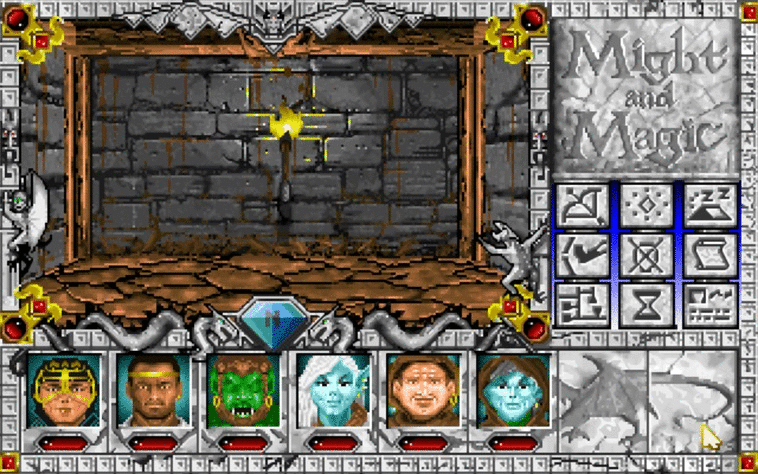
Pictured: The party currently exploring Slithercult Stronghold, standing in front of a breakable wall, at “critical” health. Rax is asleep.
The above image is actually a very crappy .gif I made. It should show some of the interface perks of Isles of Terra. The small lizard-like creature to the right waves its arm to indicate that the wall in front is actually a passage I can break through (at the cost of some health).
The gargoyle to the left is waving its wings to indicate that the party is currently levitating.
The gem at the bottom shows my current direction, courtesy of the Direction Sense skill. I’m turned northwards.
The bat above the main screen area is currently still, but if there were any enemies nearby, it to would be animated, to indicate danger. It’s sort of a spidey sense.
Lastly, it’s subtle, but you can tell that Rax (the green guy) has his eyes close. This is because he’s actually asleep, due to magical reasons.
Plans for the blog
I won’t be doing what I did with Book One and Two. I lack the time or the dedication to write as much as I did back then.
I’d rather just play the game.
The first report is this. If there’s stuff to write about, there may be a few more before I finish the game. If not, there will be one more once the game is finished. It will either be part of, or separate from the map/tips/whatever compilation I intend to write, depending on the amount of content I have.
If I sound jaded, I’m not. In fact, I enjoy doing it this way far more. I have more time to play and more time to write an article with meaningful content instead of just bland padding. I hope the few readers I have enjoy it more as well.
